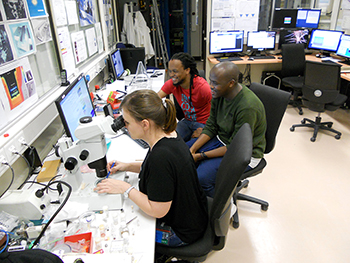
Dr Carla Pretorius mounts microcrystals with
Dumisani Kama while Pennie Mokolokolo
observe the technique.
Photo: Supplied
Crystals and crystallography form an integrated part of our daily lives, from bones and teeth, to medicines and viruses, new catalysts, jewellery, colour pigments, chocolates, analysing rocks on the moon and Mars, electronics, batteries, metal blades in airplane turbines, panels for solar energy and many more.
In spite of this, not many people know much about X-ray crystallography, although it is probably one of the greatest innovations of the 20th century, spanning the sciences. That is why this discipline is actively researched by a number of tertiary institutions around the globe as well as the Inorganic Chemistry Group of the Department of Chemistry at the University of the Free State (UFS).
Research by the Inorganic Chemistry Group includes:
• clever design of model medicines to better detect cancer and study heart, bone and brain defects;
• production of new compounds for making new and better automobile fuels and decrease carbon dioxide in the atmosphere;
• generation and purification of new South African mineral resources for metals widely used in turbines which use wind energy.
A group of UFS students have received acknowledgement for their research at six international venues in the past few months.
Posters in Cameroon
Twelve postgraduate students, together with Prof André Roodt, Head of the Inorganic Chemistry division at the UFS, delivered three oral presentations, nine posters, one plenary and one keynote lecture abroad.
Four UFS students - Nina Morogoa, Pheello Nkoe, Alebel Bilay, and Mohammed Elmakki - who delivered posters at the First Pan African Conference on Crystallography in Dschang, Cameroon, received prizes for their presentations.
School and conference in Croatia
Students Orbett Alexander and Dumisani Kama were selected to attend the intense and demanding Third European Crystallographic School in Bôl, Croatia. Both Kama, Alexander and Prof Roodt gave oral presentations at the 24th Croatian-Slovenian Crystallographic Meeting at Brac Island, Croatia.
Kama, together with Dr Ferdi Groenewald, Dr Carla Pretorius and Pennie Mokolokolo, also attended the European Synchrotron Radiation Facility (ESRF) in Grenoble, France. The ESRF is a centre of excellence for fundamental and innovation-driven research. The storage ring at this laser facility can generate X-rays 100 billion times brighter than typical medical and laboratory X-ray sources.
Research in Switzerland
Kama and Mokolokolo also spent one month on research visits at the University of Zurich in Switzerland. Both Kama and Alexander were invited to present their research orally to the Institute of Inorganic Chemistry in Zurich, headed by Prof Roger Alberto.
In Basel, Switzerland, Dr Ferdi Groenewald, Dr Renier Koen, and Dr Truidie Venter all presented their research at the 30th European Crystallographic Meeting.
Prof Roodt said: “It is incredibly important that our postgraduate students get the chance to interact, discuss, and be taught by the best in the world and realise that hard work on basic and applied chemistry processes leads to broader recognition. The delegates to these international venues came from more than 60 countries and took note of our students work. With these young researchers, our future at the UFS and at Inorganic Chemistry is in good hands”.